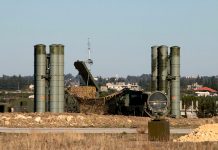
African nations have increasingly demonstrated interest in Russia’s Typhoon-PVO, a mobile air defense platform engineered to provide protective coverage in localized conflict scenarios. The system is not designed for high-intensity warfare involving advanced aerial threats such as cruise missiles or large-scale air assaults. Instead, it serves as a pragmatic solution for states engaged in lower-intensity conflicts, where insurgencies and asymmetric warfare tactics are prevalent.
Vyacheslav Dzerkaln, Deputy General Director of the Almaz-Antey air defense consortium, has noted a growing demand for the Typhoon-PVO from multiple African countries contending with persistent insurgencies and irregular threats. The system’s appeal lies in its cost-effectiveness, mobility, and operational suitability for environments where conventional military infrastructure is limited.
African militaries largely operate in theaters where the primary threats stem from non-state actors, armed militias, and insurgent factions rather than sophisticated air forces or precision-guided munitions. The Typhoon-PVO is optimized for such environments, offering mobile protection to maneuvering units, a critical capability in regions where battlefield conditions remain fluid and unpredictable. Its ability to provide on-the-move defense ensures that forces retain tactical flexibility while mitigating vulnerabilities to ambushes and sudden engagements.
The platform integrates a rotating turret housing a Kord 12.7mm heavy machine gun, which can be remotely operated from within the vehicle, preserving crew survivability. Additionally, the Typhoon-PVO supports integration with man-portable air defense systems (MANPADS), enhancing its ability to counter low-flying aircraft and unmanned aerial vehicles (UAVs)—an emerging threat in contemporary warfare.
Geopolitically, the growing interest in the Typhoon-PVO underscores the expanding security cooperation between Russia and African states. Moscow has long positioned itself as a key supplier of military hardware to the region, offering alternatives to Western defense procurement channels. Many African governments seek to diversify their defense acquisitions, leveraging Russian platforms that are perceived as cost-effective and better suited to their operational requirements. The Typhoon-PVO aligns with this approach by delivering a balance of affordability, deployability, and combat effectiveness.
From a technical standpoint, the Typhoon-PVO is based on a KAMAZ 4×4 chassis, a platform renowned for its off-road capability and reliability in harsh conditions. Its dimensions—7.2 meters in length, 2.5 meters in width, and 3.2 meters in height—allow for an optimal blend of crew capacity and mobility. A 300-horsepower diesel engine powers the vehicle, enabling speeds of up to 100 km/h on paved roads and 50 km/h off-road, ensuring rapid deployment and repositioning in active conflict zones.
The system’s armament package includes a 360-degree turret-mounted Kord heavy machine gun, which delivers sustained fire against both ground and aerial threats. It is compatible with various 12.7mm ammunition types, including armor-piercing, tracer, and high-explosive rounds, allowing engagement of diverse target sets. Additionally, its smoke-screen deployment capability provides defensive countermeasures against enemy targeting and surveillance assets.
The Typhoon-PVO’s armored hull offers protection against small-arms fire, shrapnel, and explosive fragments, making it well-suited for engagements where improvised explosive devices (IEDs) and light weaponry pose the predominant threat. Further enhancing survivability, the vehicle features an advanced fire suppression system designed to maintain operational integrity even in the event of direct enemy fire.
The rising demand for the Typhoon-PVO signals a broader shift in African defense procurement strategies, where an emphasis on mobility, adaptability, and counter-insurgency capabilities is becoming increasingly pronounced. As regional security dynamics evolve, the necessity for systems that can effectively operate in asymmetric combat environments continues to grow. In the long term, the proliferation of platforms like the Typhoon-PVO within African militaries may influence the broader strategic landscape, reinforcing Russia’s role as a defense partner and shaping operational doctrines for counterinsurgency and rapid-response engagements. The system’s ability to provide reliable force protection in contested areas underscores its significance in modernizing African military forces facing irregular threats.




